The Lady’s in Hades (original) (raw)

I’ve written a bit about Battle of Olympus before. My family rented it a few times in my childhood but could never get too far in it, maybe as far as the first Cyclops.
In terms of gameplay, it was largely based on Zelda II, with some similarity to Castlevania II as well, the tendency seemingly being to make the second game in a series a side scroller with towns and mazes, and sometimes cryptic (or at least poorly phrased) clues that various people give you. I watched a playthrough of the game recently, and I found I still remember a lot of the music. You’re constantly going back and forth between different locations to get items you need to access new stuff. There are a few different places you visit, all actual ones in ancient Greece (and one in Asia Minor), each with their own environments.
I did a quick search, and apparently there were and are caves in Argolis and waterfalls in Phthia (Achilles’ homeland), I don’t know if they were as prominent as they are in the game.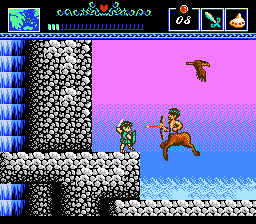
Most of the enemies you face are pretty generic animals, like monkeys that jump at your head, little bears that throw spears, and weird pink bird things that look sort of like the original concept for a Chocobo.
There are Satyrs, who will run forward and jump occasionally.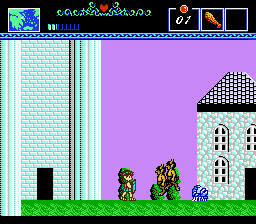
Bosses are more specific to Greek mythology, at least as far as they could do at the time. The Hydra has only one head and Cerberus only two, but they’re still there.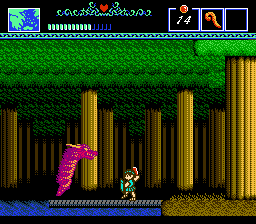
Kind of reminds me of the dragons from Metroid.
Oddly, Medusa does not appear. The game’s Lamia looks somewhat like Ray Harryhausen’s Medusa from Clash of the Titans, although I think this monster had been depicted with a snake’s body well before that.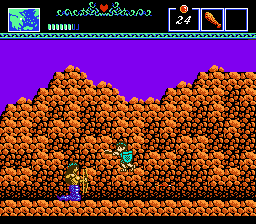
She’s described in dialogue as a vampire. While you can name your hero and the damsel in distress, his canonical name is Orpheus, and he does descend into the Underworld to rescue his sweetheart who was poisoned by a snake. Her name isn’t Eurydice, but Helene, and Hades apparently wants to marry her, so there are elements of Helen of Troy and Persephone mixed in as well. And Orpheus does a lot of fighting with weapons, unlike his mythological counterpart’s musical raid, although he does get two instruments to use. One is a harp to summon Pegasus at certain temples, and the other an ocarina that can call dolphins, and this was before Link played that instrument.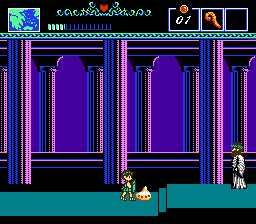
There’s also one in Dragon Quest VI, which summons a dragon. Were ocarinas known in classical Greece? There was a Neolithic one found at an archaeological site in Kosovo, so maybe. Anyway, the gods give you magical items, sort of like they did with Perseus. So it’s a bit of a hodge-podge in terms of mythology, but it definitely shows a good amount of research. Talos and the Minotaur are both on Crete, for instance. It’s interesting that this was distributed by Broderbund, which I don’t generally associate with console games. They were responsible for Carmen Sandiego, which is all about research. But they were only the American distributors for Olympus, so there’s probably no connection there. There are only two sprites for the deities, one for gods and one for goddesses. They also give you the lengthy, hard-to-read passwords that were a thing back in the NES days. The first DQ actually had a system like that in the original Famicom version, although they changed it to a password system for the American release. Oh, and olives are used as currency. One god who doesn’t help you is Hades, who’s the final boss, and you can only see his shadow because he’s wearing his helmet that makes him invisible.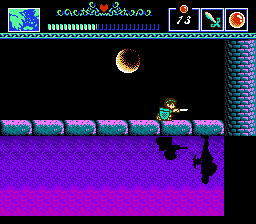
Why are the gods of the dead always villains, when they often aren’t in the surviving myths? While Hades doesn’t show up in the original Kid Icarus, which wasn’t particularly accurate to the source material, I understand he’s the final boss in Uprising.
Is Kid Icarus even set in Greece? It’s not even clear whether Angel Land refers to the entire world or just the Skyworld.
The Captain N comics did refer to its setting as Mount Olympus, but not the games themselves.

The death god uncharacteristically being the villain is a trope that also shows up in another game I’ve been looking into recently, Riddle of the Sphinx for the Atari. Beth actually has it for her 2600, although that’s not hooked up right now. It obviously has an Egyptian theme, and it’s weirdly complicated for a game of the time. It doesn’t LOOK that complex, basically just being a vertical scroller with a top-down view, where you run through the desert and throw rocks at enemies. But you have three different statistics, inner strength, health, and thirst. And not everyone who approaches you is an enemy. Many are thieves who will both hurt you and steal items, but others are traders who shouldn’t be attacked, and will swap items instead of taking them. The plot, as described in the instructions and never in the game itself, is that you’re the Prince of Egypt (no, not Moses), and you’re trying to remove a curse placed by Anubis. Both Isis and Anubis show up from time to time, and they’re decent depictions for the graphics of the time.
Anubis will hurt you, but since he’s still a god, you’ll be penalized if you attack him.
Your goal is to make a sacrifice to Ra in order to purify the land, but on the harder modes, he won’t always accept what you try to give him. You get hints throughout the game as to what item you need, but from what I’ve seen of it, I have no idea how to figure them out. I assume the Tannis Leaf, a healing item, is named after Tanis in the Nile Delta.
This entry was posted in African, Animals, Castlevania, Comics, Dragon Quest, Egyptian, Final Fantasy, Greek Mythology, Kid Icarus, Magic, Maps, Medicine, Metroid, Monsters, Music, Mythology, Names, Video Games, Zelda and tagged achilles, angel land, anubis, atari, battle of olympus, bears, broderbund, castlevania ii: simon's quest, cerberus, chocobos, clash of the titans, cyclopes, dragon quest vi, dragons, eurydice, hades, helen of troy, hydra, isis, kid icarus uprising, lamia, medusa, minotaur, monkeys, mount olympus, ocarina, orpheus, pegasus, persephone, ray harryhausen, riddle of the sphinx, satyrs, snakes, talos, underworld. Bookmark the permalink.